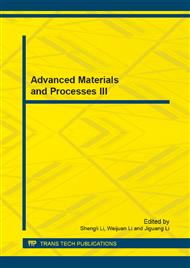p.650
p.654
p.658
p.662
p.667
p.672
p.678
p.686
p.691
Application of Melt Extrusion Process for an In Situ Polymers Blend of Cellulose with Polyethylene Glycol in the Presence of Ionic Liquid
Abstract:
To modifying cellulose through an eco-friendly process, an in-situ chemical blend modification of microcrystalline cellulose with PEG2000 was conducted by using co-rotating twin-screw extruder through a reactive extrusion process in the presence of IL namely, 1-N-butyl-3-methylimidazolium chloride which, was acting as plasticizer and solvent for cellulose . The modified cellulose (cellulose/PEG) was characterized by polarization optical images (POM), FT-IR, XRD and thermogravimetric analysis. The POM and XRD confirmed that cellulose I was changed into cellulose II. The FTIR and X-ray scattering showed that the cellulose hydrogen bond was disturbed through the extrusion, and strong interactions occurred between cellulose molecules and PEG which improved the thermal stability and decreased the degree of crystallinity.
Info:
Periodical:
Pages:
667-671
Citation:
Online since:
September 2013
Authors:
Keywords:
Price:
Сopyright:
© 2013 Trans Tech Publications Ltd. All Rights Reserved
Share:
Citation:


